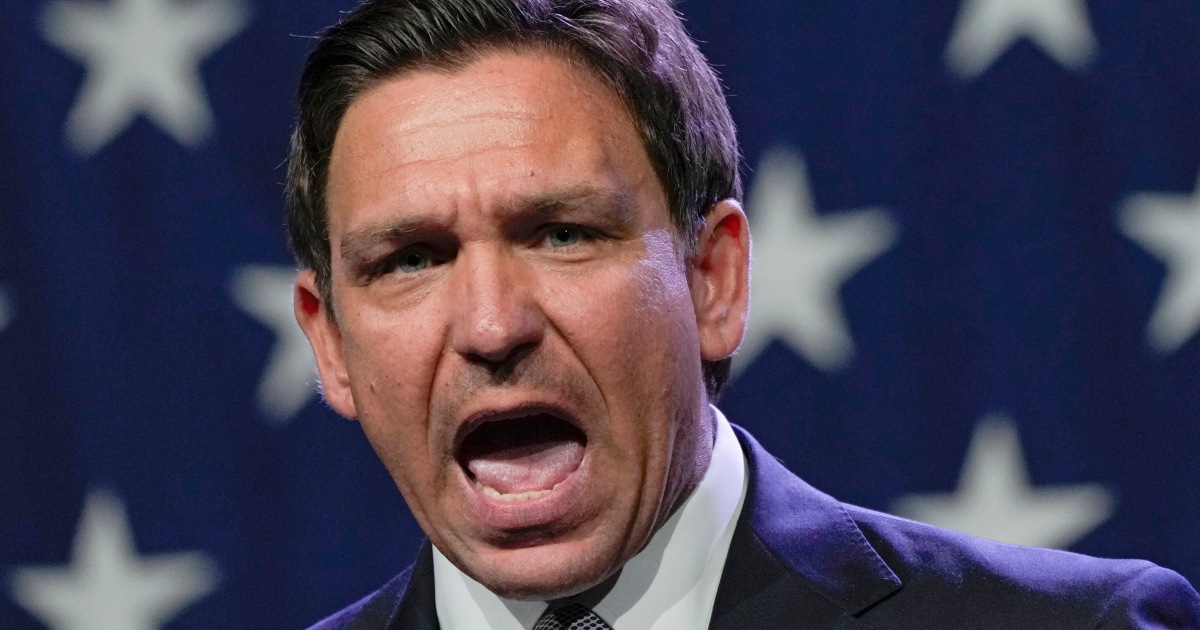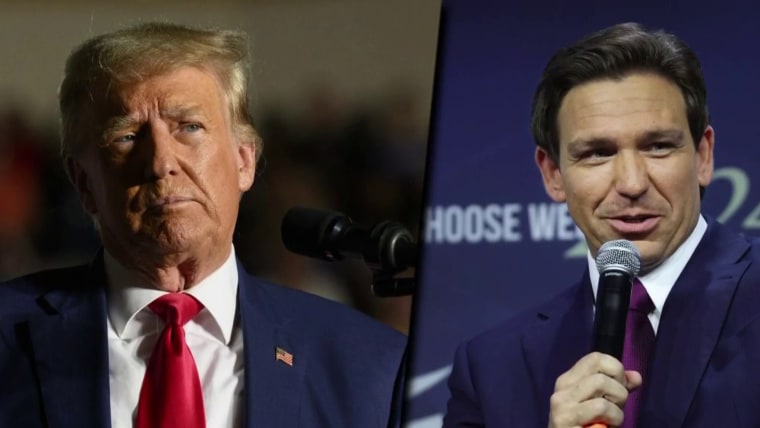TALLAHASSEE, Fla. — For the first five months of Gov. Ron DeSantis’ high-profile mission to stop migrants from coming into the Florida Keys, state law enforcement agents were conducting surveillance flights that went against state policies and best safety practices, according to internal records obtained by NBC News.
On Jan. 6, DeSantis signed an executive order activating the Florida National Guard and state law enforcement agents for his anti-migrant Keys mission. It was widely seen as an escalation of his political fight with the White House ahead of his eventual presidential campaign.
State law enforcement agencies have increasingly become key to parts of DeSantis’ campaign, in the areas of immigration, voting rights and his own traveling security as he runs for president.
After his Keys order, Florida Department of Law Enforcement Commissioner Mark Glass, a DeSantis appointee and ally, informally waived existing department policies so that agents could use airplanes less suited for surveillance missions over water. He also allowed those airplanes to fly significantly further offshore in search of migrant vessels than is generally allowed, according to FDLE internal emails.
Those decisions increased the likelihood of a water landing, which would put FDLE agents’ lives at risk, according to five independent aviation experts interviewed by NBC News.
“Flipping the aircraft upside down when touching the water, difficulty egressing the aircraft, putting on life jackets, accessing a life raft,” said David Evans, an airline transport pilot and flight instructor based in California. “All of these issues greatly enhance drowning quickly.”
FDLE said it acknowledged and addressed concerns earlier this year about the Keys mission.
“This year, FDLE leadership made a series of changes to the aviation unit to enhance safety and efficiency including addressing the concerns some of our pilots raised to you,” FDLE spokeswoman Gretl Plessinger told NBC News.
She said Glass “hired an outside aviation expert” and ordered a “top-down analysis of the unit” that led to changes, including reorganizing the unit, hiring a safety officer and additional pilots, and establishing an incentive pay plan. FDLE also bought additional aircraft, and pilots no longer uses a single-engine Cessnas for the Florida Keys missions, as they did for roughly five months when the operation began.
Plessinger did not respond to a direct question about why Glass approved missions at odds with FDLE’s own policies for months after the January Florida Keys mission began.
During those early months, FDLE pilots were using a single-engine Cessna to fly over water to search for migrant boats — which in most cases is in violation of the department’s own policy. Those policies dictate that “over water” operations should be done by “multi-engine aircraft,” and that single-engine aircraft should be used only when in “power off gliding distance” from land, according to a copy of the FDLE handbook NBC News reviewed.
It is an unacceptable level of risk for a pilot.
John Cox, president and ceo of Safety Operating systems
Surveillance missions had to be done at low altitudes — generally around 1,000 feet — in order to spot potential migrant vessels. But that meant those planes should not have been out more than 2 or 3 miles from land, according to department policy.
An FDLE chart sent to the aviation unit ahead of its deployment to the Florida Keys showed that every 1,000 feet above the water allowed a single-engine Cessna to be another mile out away from land, according to a copy reviewed by NBC News.
In some cases, however, they were sent between 20 and 30 miles offshore based on Glass’ order, according to FDLE records.
“It is an unacceptable level of risk for a pilot,” said John Cox, who is president and CEO of aviation safety company Safety Operating Systems and a veteran major airline, corporate and general aviation pilot. “If you have a single-engine problem, you have a 100% chance of going in the water. And it will happen quickly.”
Kit Darby, who owns KitDarby.com Aviation Consulting, LLC in Georgia, called it a potential for disaster.
“Definitely a recipe for a water landing if the engine quits,” he said. “You can only glide after an engine failure about 1½ miles at 1,000 feet.”
“You have to be nuts to be 30 miles offshore at that altitude in single engine aircraft,” said David Katzman, a Michigan-based aviation law attorney and expert.
“One of the basic safety rules in aviation is to be able to find a suitable place to land the aircraft, in case of an engine failures,” Ross Aimer, CEO of Aero Consulting Experts, said. “At 1,000 feet above water, very little distance remains to glide to the shoreline, if your engine quits.”
The fact that a single-engine Cessna would be used to start the Florida Keys mission was relayed in an email from FDLE Chief Pilot Barry Brown to the aviation unit Jan. 6, the same day DeSantis ordered the mission.
“We will be utilizing our Cessna aircraft until our King Air is operational again hopefully, by the end of the month,” he wrote.
The Cessna was used through at least the beginning of May, according to an FDLE source familiar with the situation. After that, the agency leased a multi-engine plane to conduct the surveillance missions, according to the source.
Almost immediately, some FDLE agents expressed concerns about using a single-engine plane.
One early mission to the Marquesas, an uninhabited island that would require flying a single-engine plane over the open water for at least 20 to 25 miles at low altitudes — significantly farther than FDLE policy allows — raised alarms.
“I have a mission task this morning to fly to the Marquesas to check for migrants,” FDLE pilot John Beuth wrote in a Jan. 12 email to Brown. “I obtained a local spotter. As you know, the mission contradicts sections of the flight manual ie overwater [operations]…I’m pretty certain you are aware.”
Brown responded that Beuth — who is no longer with the FDLE — could call “with any questions or concerns.”
About three hours later, Beuth put in an email the contents of the phone call he had with Brown, his supervisor, including an understanding that the mission directly violated department policy.
“Per our phone conversation today regarding the current operational flight profile here in the keys, that certain mission assignments will conflict with our Flight manual/Policy, and it is your understanding that due to the mission being ordered by Commissioner Glass, those deviations are approved. That is my current understanding,” he wrote.
Brown, sent a one word response: “correct.”
Plessinger, the FDLE spokeswoman, said agents “routinely assume high-risk missions whether in the air or on the ground.”
“Regarding the mission you mention, FDLE analyzed the risk and put additional risk control measures in place to lower that risk,” she said, without offering specifics.
She said if any FDLE pilot feels a mission is unsafe, they “do not have to fly the mission, but a risk assessment form should be completed.”
Two months later, another FDLE pilot named Rob Robbins emailed Brown with his concerns about the mission.
“The mission profile runs counter to the FDLE Flight Guidance Procedures,” he emailed March 9. “I am looking for confirmation from you that I am to fly the mission.”
Eight minutes later, Brown said that “the mission profile is the same for you as it has been for all the previous pilots which was approved by command staff.”
NBC News also reached out to Beuth, Robbins and DeSantis’ office. None returned requests for comment.
Robbins is currently facing disciplinary action from the FDLE for what an anonymous letter alleges was his violation of department policy.
During a hearing last week in front of the Public Employee Relations Commission, which hears interagency disputes related to public employees, the FDLE had several witnesses lined up to testify. But after members of the media announced they were on the conference call, there was a nonpublic negotiation. Later, there was an announcement that Robbins’ previous three-day suspension without pay was being forgiven and replaced with a written reprimand, a move Robbins said he disagreed with. The reduced penalty removes the the issue from the commission and allows FDLE to handle it internally.
Plessinger, the FDLE spokeswoman, did not respond to questions sent Friday about why the agency agreed to settle the issue even after past negotiations had failed.
The emails reviewed by NBC News were submitted as evidence as part of that hearing.
In response to questions about pilot concerns around the Keys mission, FDLE provided the internal affairs investigation into Robbins. The allegations were that in late October, Robbins was on-call to fly DeSantis and his family but left Tallahassee “to locate a missing cow in the Central Florida area.” His absence left no other pilots available to fly DeSantis or his family if needed, as is the role of the on-call pilot.
Five specific allegations were levied against Robbins, including not exercising good judgement, misuse of resources and violating general flight procedures.
In a written response to the commission, Robbins said he believes the anonymous complaint had “factually incorrect information” and was in retaliation for him raising safety concerns.
“I believe that this investigation was started as an attack and revenge against me for having raised safety issues within the FDLE Aviation Unit,” he wrote. “The decision to proceed with an investigation was based on an anonymous letter containing factually incorrect information.”
Aviation experts who reviewed the FDLE’s overwater mission policy said it is sound, and that there is generally no reason one individual — in this case, Glass, the DeSantis-appointed FDLE commissioner — should overrule it, especially for a mission perceived as so closely tied the governor’s political agenda.
“The policy is a very good policy and well-written,” said Evans, the California-based flight instructor. “There is no reason to violate it in this instance. Political pressure that compromises the safety of pilots and public through unilateral decision making, in my opinion, is egregious.”
The FDLE has faced scrutiny as it plays an increasingly central role in DeSantis’ agenda. Aside from the immigration mission, it helped enforce charges brought by a controversial election investigations office the governor created in 2022. Agency resources were also diverted to DeSantis’ security as he crisscrossed the country in the lead-up to his presidential bid; the agency said the changes were in the works for a long time and not about politics.
“There has been a push of trying to get FDLE to focus on topics the governor has highlighted, specifically immigration as the primary one,” Jim Madden, a retired FDLE assistant commissioner, said in an interview at the time. “It is sad. We have fought those battles over the years about agency priorities and where it should focus, but right now in my mind, leadership there is just wholly inadequate.”
“There is no solid independence with the agency,” he added.

